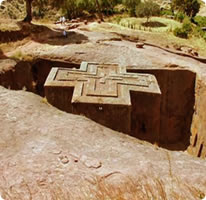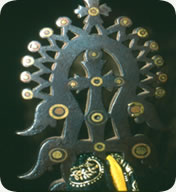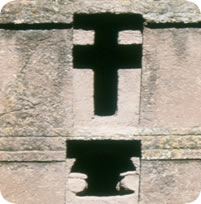|
Lalibela /Roha/ is the site of Lalibela Rock Hewn Churches. King Lalibela is responsible for the foundation of these world famous rock hewn churches in Lalibela /Roha/ town. King Lalibela was from Zagwe Dynasty, the Dynasty that came to power after the collapsing down of Axumite Dynasty. It is miraculous to see the typical Axumite architecture and early Christian basilica on these rock hewn churches in addition to its own art and aesthetic value. All the churches were chiseled and carved from red tuff volcanic rock.
In general, there are 11 rock-hewn churches in three groups in Lalibela town which all of them were chiseled and carved within 23 years in 12th century A.D. Many Ethiopian Christians consider Lalibela as the Second Jerusalem because of the holiness of the place. However, UNESCO as world heritage site registered it; unofficially scholars recognize it as one of the wonders in the world. Because of his wonderful deed later on, Ethiopian Orthodox canonized King Lalibela as Saint.
The first group of churches
 Bet Medhane Alem (House of the Redeemer of the World) Bet Medhane Alem (House of the Redeemer of the World)
It is the largest of all rock-hewn churches of Lalebela. It measures 33.7 m in length, 23.7 m in width and 11.5 m in height. The first impression of this church is the saddle-backed roof with frieze of round arches in relief along the vertical edge of the roof.The interior part consists of basilica characteristics, windows for directing light, gallery, the tomb of the three fathers (Abreham, Isaac and Jacob). Afro Ayegaba cross (Lalibela cross) made of Gold 7 kg in weight from 12th century is found here.
Bet Mariam (the house of St. Mary) – This church is known for its decorated frescoes, paintings on the walls, pillars, and ceiling. The pillar on which words of God (Alpha and Omega) are written and covered with white cloth is found here. It has also a gallery with seven windows. Its courtyard consists of fertility pool, baptism pool and Christmas celebration also takes place here.
Bet Meskel (the house of Cross) – it is small semi-monolithic church north of Bet Mariam. The bronze made of processional cross and the old “manber” (an alter on which a ‘tabot’ is put) are visited inside the church.
Bet Danagil (the house of Virgins) – It is semi-monolithic church located south of Bet Mariam. This church lacks any decoration. However, the bronze made processional cross makes worth to visit. 
The twin churches of Bet Debre Sina and Golgotha with Selassie Chapel
The first church to be visited is a semi-monolithic Debre Sina church. The cruciform pillars with the relief of Greek crosses are the first impression of the church. North of it is Bet Golgotha. On the interior walls of Bet Golgotha, a priest depicts twelve saints in relief as twelve apostles. The tomb of King Lalibela, the representations of Bethlehem and Nazreth, the processional cross of Lalibela made of three materials (Gold, Silver and Iron) are found in Bet Golgotha.
The Selassie Chapel (Trinity) is on the east side of Bet Golgotha. It is not allowed for anybody to enter.
The tomb of Adam – It is a huge square block of stone stands on western face of Bet Golgotha to symbolize the tomb of Adam.
The second group of churches
These churches are separated from the first group of churches by excavated Jordan River.
Bet Gabriel- Raphael (the house of Archangels) –the western façade gives good impression to this church. Down in the courtyard there is a well and an underground cistern. Its plan and orientation is completely different from the rest of the churches. But the golden and bronze two processional crosses, the parchment, and the two old small boxes are the main artifacts to see.
Bet Mercurios (the house of Mercurios) – In spite of its simple plan and orientation, a fine mural on the pillar, the paintings on the cotton fabrics and the beautifully designed processional cross are worth to visit.
Bet Lehem (the chapel of Bethlehem) – It is found before Bet Mercurios just at the gate of the dark tunnel that leads to Bet Mercurios. According to priests from Lalibela churches Bet Lehem was used for the bakery of the eucharitic bread.
 Bet Emanuel (the house of Emanuel) – It is the finest and most impressive rock hewn church. It is also noted for the typical Axumite architecture and true basilica plan. Inside the church from the right side, there is closed tunnel that used to take to Bet Merkurios. A wooden and bronze processional crosses can be shown to visitors. Bet Emanuel (the house of Emanuel) – It is the finest and most impressive rock hewn church. It is also noted for the typical Axumite architecture and true basilica plan. Inside the church from the right side, there is closed tunnel that used to take to Bet Merkurios. A wooden and bronze processional crosses can be shown to visitors.
Bet Aba Libanose (the house of Aba Libanose) – It is a typical rock hewn church. Legend states that this church was chiseled, carved and finished within 24 hours. After visiting the interior part of the church and two small processional crosses, it is possible to go around the exterior church to appreciate how the walls are detached and the roof is still connected with mother rock.
The third group church – Bet Ghiorgis
Bet Ghiorgis (the house of St. George) is isolated church from both the first group and second group of churches. It is the most stylish, graceful, and refined in architecture, and cruciform church. The first impression starts from small hill where it is most spectacular scenery is seen towards three crosses on top. The narrow long tunnel leads to its courtyard. The twelve upper functional windows with ogee-arches and the decorated cross-are the exterior beauty of the church. Inside the church the two processional crosses, the royal box from 12th century and the parchment are visited.
Churches near Lalibela
 Yemerehana Krestos Cave Church – It is located 42 kms from Lalibela. It is a built up cave church founded in 11/12th century by King later on Saint Yemerehan Krestos. It is built on water body.Under a cave there are skeletons of many people, that is said by priests it is the sekeletons of the pilgrimage from Egypt. At the back of the church, the tomb of Saint Yemerehana Krestos is found. The church is a work of great elegance and consists of those of Axumite architecture. The interior church has pillars and arches, well elaborate nave ceiling, aisle ceiling with different patterns and paintings with depiction of animals like elephant and lion, a dome over sanctuary. Yemerehana Krestos Cave Church – It is located 42 kms from Lalibela. It is a built up cave church founded in 11/12th century by King later on Saint Yemerehan Krestos. It is built on water body.Under a cave there are skeletons of many people, that is said by priests it is the sekeletons of the pilgrimage from Egypt. At the back of the church, the tomb of Saint Yemerehana Krestos is found. The church is a work of great elegance and consists of those of Axumite architecture. The interior church has pillars and arches, well elaborate nave ceiling, aisle ceiling with different patterns and paintings with depiction of animals like elephant and lion, a dome over sanctuary.
The highest mountain in the area, Mt. Yoseph (4190 m.) can be seen before 6 kms from Yemerehana Krestos.
Bilbala Giorgis – 32 kms from Lalibela. It is only the façade that is visible but the rest are still connected with mother rock.
Bilbala Cherqos – 30 kms from Lalibela. It is semi-monolithic church. The paintings inside the church are nice to visit.
Arbatu Ensessa (the four beasts of animals) – 36 kms from Lalibela on the way to Yemerehan Krestos.The Axumite architecture on the pillars and windows are good to visit.
Makina Medhane Alem – It is a cave church. The Axumite style and the rich paintings, motifs are appreciated.
Gennata Mariam – about 30 kms from Lalibela. It is a true monolithic rock hewn church near Lalibela.
Back to Top
|




 Bet Medhane Alem (House of the Redeemer of the World)
Bet Medhane Alem (House of the Redeemer of the World)
 Bet Emanuel (the house of Emanuel) – It is the finest and most impressive rock hewn church. It is also noted for the typical Axumite architecture and true basilica plan. Inside the church from the right side, there is closed tunnel that used to take to Bet Merkurios. A wooden and bronze processional crosses can be shown to visitors.
Bet Emanuel (the house of Emanuel) – It is the finest and most impressive rock hewn church. It is also noted for the typical Axumite architecture and true basilica plan. Inside the church from the right side, there is closed tunnel that used to take to Bet Merkurios. A wooden and bronze processional crosses can be shown to visitors. Yemerehana Krestos Cave Church – It is located 42 kms from Lalibela. It is a built up cave church founded in 11/12th century by King later on Saint Yemerehan Krestos. It is built on water body.Under a cave there are skeletons of many people, that is said by priests it is the sekeletons of the pilgrimage from Egypt. At the back of the church, the tomb of Saint Yemerehana Krestos is found. The church is a work of great elegance and consists of those of Axumite architecture. The interior church has pillars and arches, well elaborate nave ceiling, aisle ceiling with different patterns and paintings with depiction of animals like elephant and lion, a dome over sanctuary.
Yemerehana Krestos Cave Church – It is located 42 kms from Lalibela. It is a built up cave church founded in 11/12th century by King later on Saint Yemerehan Krestos. It is built on water body.Under a cave there are skeletons of many people, that is said by priests it is the sekeletons of the pilgrimage from Egypt. At the back of the church, the tomb of Saint Yemerehana Krestos is found. The church is a work of great elegance and consists of those of Axumite architecture. The interior church has pillars and arches, well elaborate nave ceiling, aisle ceiling with different patterns and paintings with depiction of animals like elephant and lion, a dome over sanctuary.